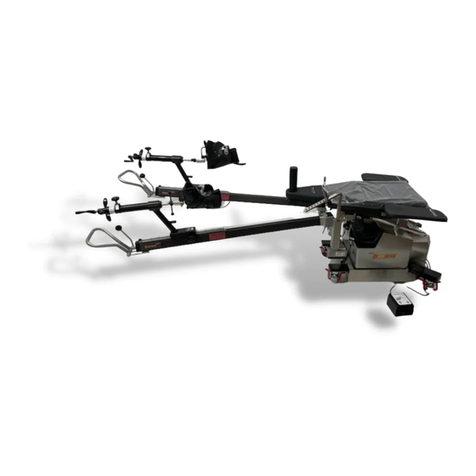
MIZUHOSI 2009 NW0504 Rev. D
4
TABLE OF CONTENTS
1.0 OVERVIEW.........................................................................................................................................6
1.1 General Description ......................................................................................................................6
1.2 Storage..........................................................................................................................................6
1.3 Acceptance & Transfer..................................................................................................................6
1.4 Inspection and Transfer ................................................................................................................6
2.0 COMPONENT IDENTIFICATION.......................................................................................................7
2.1 Jackson Spinal Surgery Top.........................................................................................................7
2.2 Radiolucent Imaging Top..............................................................................................................8
2.3 H-Frame........................................................................................................................................8
2.4 T-Pin..............................................................................................................................................9
2.5 Patient Safety Straps ....................................................................................................................9
2.6 Articulating Arm Board Assembly..................................................................................................9
2.7 Cervical Traction Vector..............................................................................................................10
2.8 Pulley Assembly..........................................................................................................................10
2.9 Coupling Device Identification.....................................................................................................11
3.0 TABLE TOP COUPLING PROCEDURES .......................................................................................12
3.1 5890/5891 Modular Table Bases................................................................................................12
3.2 5890/5891 Patient Transfer Safety Lock.....................................................................................12
3.3 5890/5891 Rotational Friction Control ........................................................................................13
3.4 Twenty-Five Degree Rotation Stop.............................................................................................13
3.5 Installing The H- Frames............................................................................................................14
3.6 Selecting The Mounting Holes For The Table Top.....................................................................15
3.7 5892/5803 Advanced Control Base............................................................................................17
3.8 5892/5803 Table Control Identification.......................................................................................17
3.9 Rotation Safety Lock Switch .......................................................................................................18
3.10 180° Rotation Lock Indicator.....................................................................................................18
3.11 Tilt Drive Status Indicator..........................................................................................................19
3.12 Installing The H-Frames............................................................................................................19
3.13 Selecting The Mounting Holes For The Table Top...................................................................20
4.0 IMAGING PROCEDURES................................................................................................................21
4.1 5890/5891 Modular Table Bases ............................................................................................21
4.2 5892/5803 Advanced Control Bases.......................................................................................21
5.0 SUPINE POSITIONING FOR ANTERIOR SPINE SURGERY AND PROCEDURES .....................23
5.1 5890/5891 Modular Table Bases ............................................................................................23
5.2 5892/5803 Advanced Control Bases.......................................................................................23
6.0 LATERAL POSITIONING FOR LUMBAR & THORACIC SPINE SURGERY AND PROCEDURES..
...........................................................................................................................................................25
6.1 5890/5891 Modular Table Bases ............................................................................................25
6.2 5892/5803 Advanced Control Bases.......................................................................................25
7.0 PRONE POSITIONING FOR POSTERIOR SPINE SURGERY AND PROCEDURES....................27
7.1 5890/5891 Modular Table Bases ............................................................................................27
7.2 5892/5803 Advanced Control Bases.......................................................................................27
7.3 5943AP Jackson Spinal Surgery Top with Advanced Control Pad System............................28
7.4 Patient Support Pad Operation................................................................................................28
7.5 Selection Of Hip Pads .............................................................................................................29
7.6 Use Of The Leg Sling..............................................................................................................30
7.7 Selection Of Head Support Method.........................................................................................31
7.8 Transferring The Patient..........................................................................................................33
7.9 Positioning Of The Head .........................................................................................................33
7.10 Positioning Of The Arms..........................................................................................................33
7.11 Positioning Of The Chest.........................................................................................................33
7.12 Positioning Of The Hips And Thighs .......................................................................................34
7.13 Positioning Of The Legs..........................................................................................................35




























